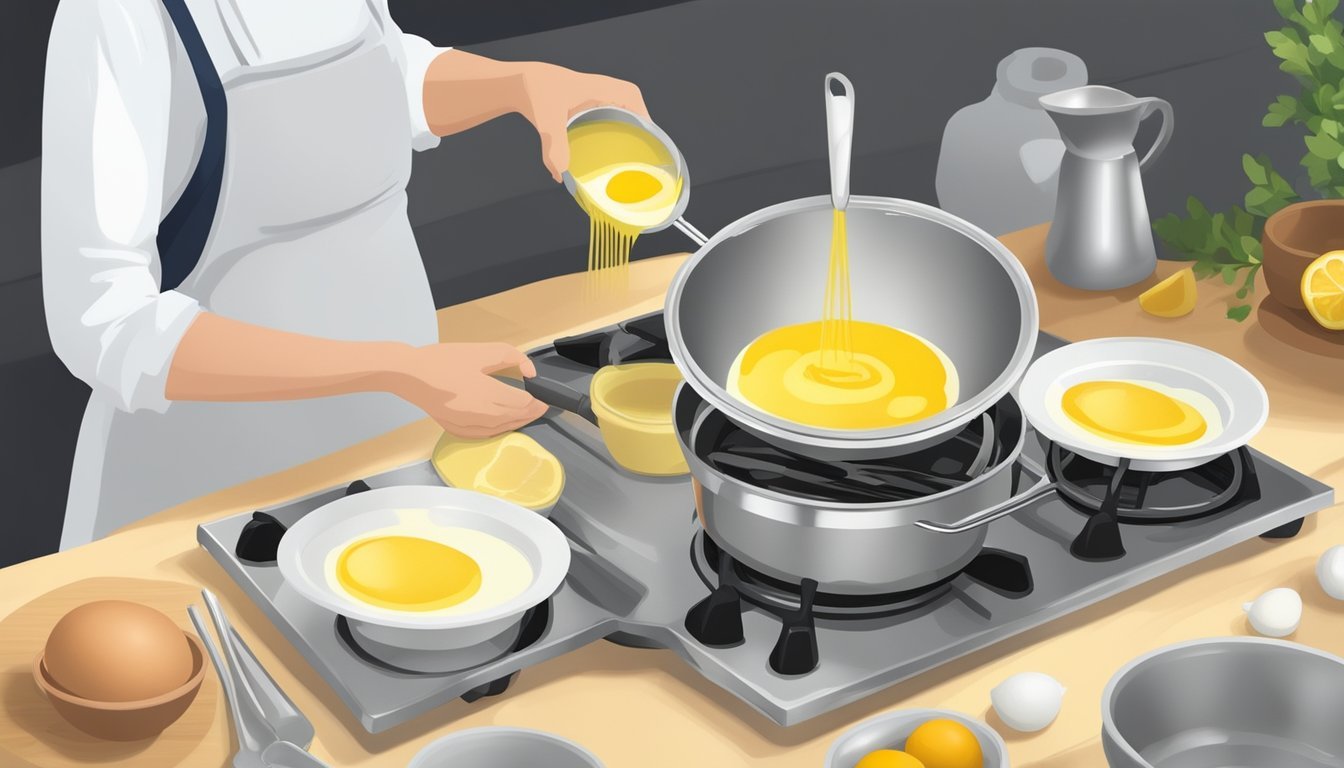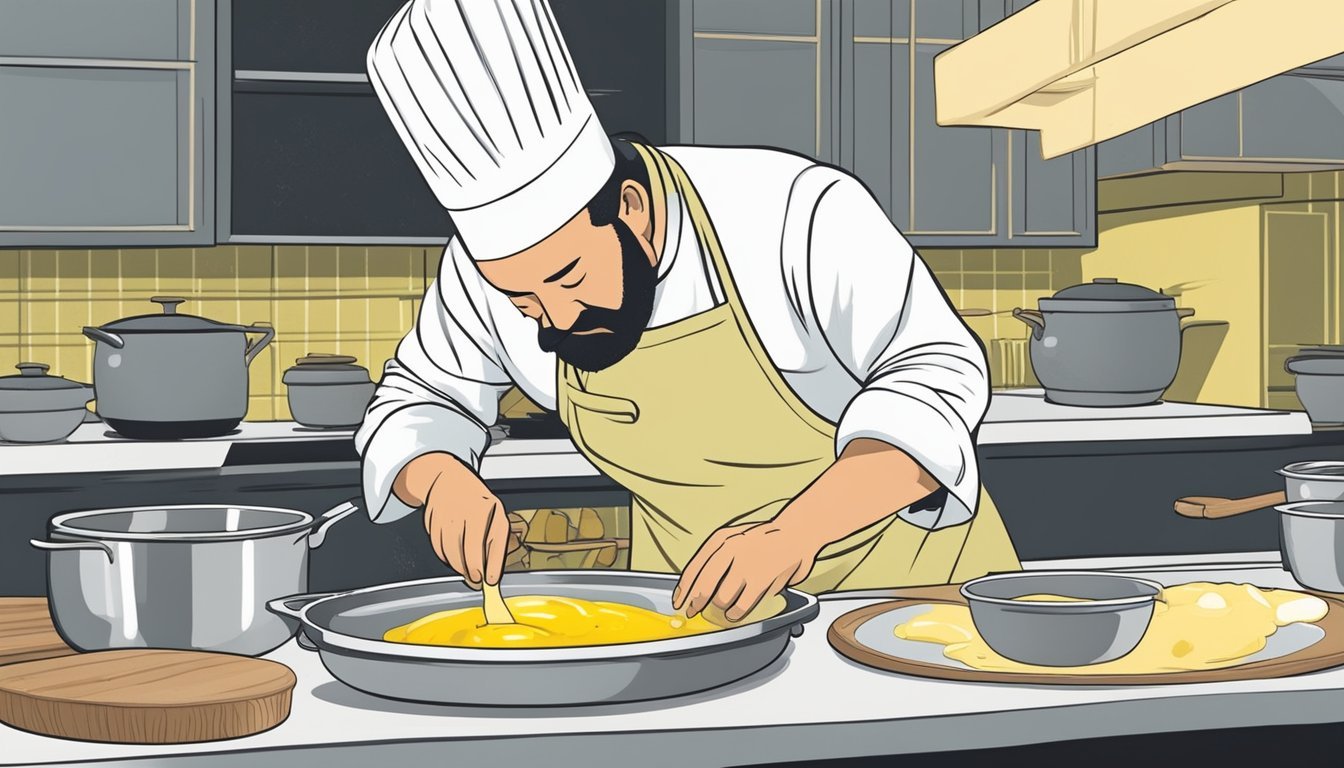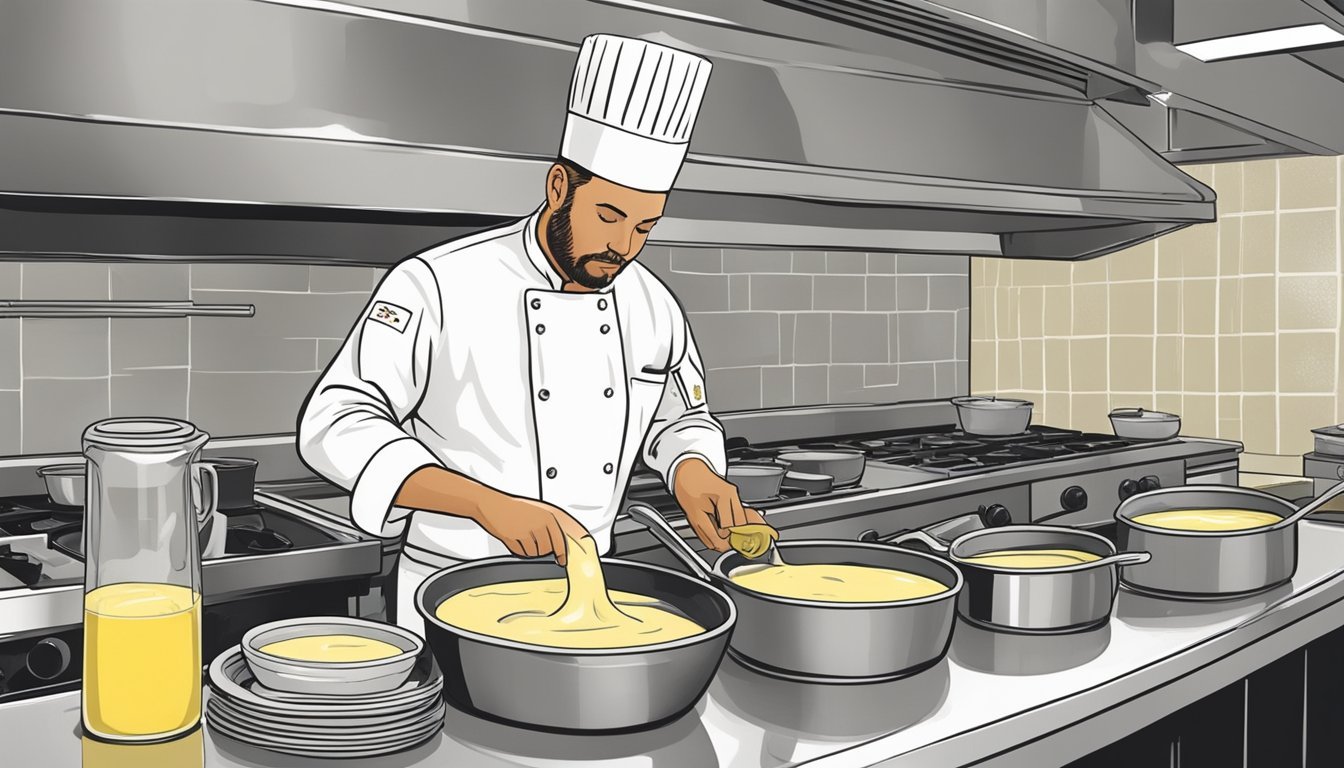Fixing Watery Béarnaise Sauce
Mastering Thickness for the Perfect Steak Topping
Béarnaise sauce is a classic French emulsion of egg yolk, butter, white wine vinegar, and herbs, most notably tarragon and chervil. It is esteemed for its rich, buttery flavor with a hint of acidity, making it the perfect accompaniment to steak. However, when the sauce turns watery, it not only loses its desired consistency but also its ability to cling to and complement the steak. This can result from factors such as over-whisking, improper emulsification, or temperature mismanagement.
Understanding the science behind emulsion can be the key to rescuing a watery béarnaise. The sauce requires a delicate balance where egg yolks act as an emulsifying agent, allowing water and fat to merge into a creamy blend. If this balance is disturbed, the sauce may split and become too thin. Techniques such as whisking over controlled heat and incorporating the butter slowly can prevent and repair a broken sauce.
When a béarnaise is thinner than desired, chefs can apply various thickening techniques to restore its luxurious texture. The process might involve gentle reduction over heat or troubleshooting steps such as adding water a teaspoon at a time to adjust thickness. Whether the silky sauce is served immediately or kept warm for later use, maintaining the right viscosity ensures that it envelops the steak in a velvety coat, enhancing the dish's overall flavor profile.
Understanding Béarnaise Sauce
Béarnaise sauce is a classic accompaniment for steak, known for its rich, buttery flavor and distinct use of tarragon. This section explores its roots, key ingredients, and how it stands apart from other sauces in French cuisine.
History and Culinary Significance
Béarnaise sauce, a derivative of the famed Hollandaise sauce, holds an esteemed place among the French mother sauces. Its origins trace back to the 19th century in France, where it quickly became a prestigious element at fine dining establishments. The sauce's name is believed to be derived from the historical province of Béarn, although its exact historical ties to the region are often debated.
Key Ingredients
The foundation of béarnaise sauce is a combination of clarified butter, egg yolks, and a reduction of vinegar and tarragon. It's this distinctive use of tarragon that imbues béarnaise with its unique taste profile. The key ingredients include:
Clarified butter: Contributes to the smooth and creamy texture.
Egg yolks: Act as an emulsifying agent.
Tarragon: Adds the characteristic anise-like flavor.
Vinegar reduction: Vinegar often combined with shallots, chervil, and peppercorns.
Comparison to Hollandaise Sauce
Béarnaise and Hollandaise are frequently mentioned together as they share a similar base of emulsified butter and egg yolks. However, béarnaise sauce distinguishes itself by its notable incorporation of a tarragon and vinegar reduction, contrasting with the lemon juice flavoring found in hollandaise. Both belong to the family of five mother sauces deemed essential in classical French cuisine, but béarnaise is often viewed as a variation of hollandaise rather than a mother sauce in its own right.
Preparation Basics
Creating the perfect Béarnaise sauce is about mastering a few key steps: following a classic recipe, selecting premium ingredients, and understanding the emulsion process.
Classic Béarnaise Sauce Recipe
A classic Béarnaise sauce starts with reducing white wine, vinegar, shallots, peppercorns, and herbs until the liquid is decreased by at least half. This concentrated mixture is then combined with egg yolks and water to form the base of the emulsion. Clarified butter is gradually incorporated while maintaining a consistent temperature to avoid curdling.
Choosing the Right Ingredients
Quality ingredients are essential for a flavorful Béarnaise. Fresh tarragon is preferred for its aromatic properties. Use white wine vinegar for a balanced acidity. Clarified butter provides a smooth, rich taste without the milk solids found in regular butter. Shallots should be fresh and finely chopped for a subtle depth of flavor.
The Technique of Emulsion
Emulsification is the process that holds Béarnaise sauce together. Gently warm the egg yolk mixture over a double boiler, never allowing it to boil, to achieve a creamy consistency. Gradually add melted clarified butter, whisking continuously. If the sauce splits, a splash of water can help to re-emulsify it, as can using a stick blender for a quick fix.
Common Issues and Fixes
In addressing watery Béarnaise sauce, it's essential to understand the common causes and apply the appropriate fixes. Textural integrity and maintaining a stable emulsion are crucial for the perfect topping on steak.
Diagnosing Watery Béarnaise
Watery Béarnaise sauce often results from issues with emulsion or temperature mishandling. Emulsion is the process where the ingredients, particularly the fat from the butter, are suspended within the liquid uniformly. If the sauce fails to thicken, it indicates that the butter hasn't properly emulsified with the egg yolks and other ingredients.
Over-Whisking: Can break down the emulsion.
Lemon Juice: Adding it too early can prevent proper emulsion.
Thickening Techniques
Restoring the desired texture to a watery Béarnaise includes subtle interventions that don't require starting from scratch.
Blender or Immersion Blender: A quick pulse can re-emulsify.
Heat Application: Gently warming the sauce while whisking can reestablish the emulsion.
Note: Do not use a microwave which can unevenly heat and further break the sauce down.
Temperature Control
Temperature plays a pivotal role in the consistency of a Béarnaise sauce. The sauce needs gentle heat to thicken but can separate if overheated.
Keep Warm: The sauce should be kept warm until serving to maintain emulsion.
Reheating: If the sauce has thickened after cooling, carefully bring it back to temperature by whisking over a double boiler or gentle heat.
Culinary Applications
Thick, velvety Béarnaise sauce enhances not only steak but a wide range of dishes with its rich, buttery flavor profile. Here's how chefs and home cooks alike can leverage this classic French sauce in various culinary scenarios.
Best Pairings with Steak
Filet Mignon: The tender and mild flavor of filet mignon is beautifully complemented by Béarnaise sauce, adding a luxurious dimension without overpowering the meat.
Ribeye: A robustly flavored ribeye can stand up to the boldness of Béarnaise, balancing the richness of the cut with the sauce’s herby tang.
In addition to these classic pairings, the sauce can be lightly drizzled over slices of beef to enhance the natural flavors.
Alternative Uses in Cooking
Fish and Chicken:
For fish, a light touch of Béarnaise adds a zesty contrast to the delicate flavors of seafood.
Chicken, especially when roasted or grilled, benefits from the sauce's moisture and depth.
Eggs and Vegetables:
Eggs Benedict: Béarnaise can be a flavorful alternative to Hollandaise on this breakfast staple.
Vegetables: Steamed or roasted vegetables, such as asparagus or artichokes, (What wine goes well with artichokes?) reach new heights when draped in the sauce.
Salads:
A small quantity of Béarnaise can double as an indulgent dressing for a green salad, adding a twist to the traditional vinaigrette.
In these applications, the consistency of the Béarnaise is key; it should cloak the food with a luxurious layer without being too thick or too runny.
Advanced Tips and Variations
In perfecting the Béarnaise sauce, one may seek to enhance its flavor or even create new sauces based on the original recipe. These advancements not only enrich the taste but also offer a unique twist to the traditional steak topping.
Flavor Enhancements
Fresh Tarragon: The role of fresh tarragon cannot be overstated when it comes to Béarnaise sauce. Its distinct taste is a pillar of the sauce’s flavor profile. To intensify this flavor, one can add an additional pinch of finely chopped tarragon just before serving.
Infused Vinegar: For a more complex tang, chefs may infuse vinegar with additional herbs. Champagne vinegar infused with a bouquet of fresh herbs such as chervil and tarragon adds a sophisticated note to the sauce.
Creating Derivative Sauces
Chervil's Role: Incorporating chervil, in addition to tarragon, introduces a mild hint of anise to the sauce. This subtle addition can be the foundation for derivative sauces, like a Béarnaise modified with other fresh herbs or ingredients to suit specific dishes.
Chimichurri-Inspired Béarnaise: By adding ingredients typical of chimichurri sauce, such as parsley, garlic, and red pepper flakes, one can transform the European classic into a South American twist suitable for a range of meats.
These enhancements and variations breathe new life into the classic Béarnaise, allowing chefs and home cooks alike to customize the sauce to their personal preferences or specific culinary creations.
Health and Nutrition
In discussing health and nutrition as it relates to Béarnaise sauce, one must consider the nutritional content of the sauce and how it fits into various dietary considerations. The use of butter and the potential for reduced-fat substitutes significantly impacts the health profile of the sauce.
Analyzing Nutritional Content
Béarnaise sauce is traditionally rich in fats, primarily due to its butter content. The choice between using unsalted butter and salted butter affects both the nutritional value and taste. Unsalted butter is preferred for its pure flavor, allowing for controlled seasoning. The primary components of butter are fat and milk solids, which provide a creamy texture and flavor to the sauce. Ghee, a type of clarified butter with the milk solids removed, may be used as an alternative; it is rich in fat-soluble vitamins A, E, and D.
Component Considerations Unsalted Butter Offers control over salt content, contains fat and milk solids. Salted Butter Higher in sodium, affecting individuals with sodium-restricted diets. Ghee Lactose-free, contains fat-soluble vitamins, and often used in cases of dairy sensitivity.
Dietary Considerations
Individuals adhering to low-fat or heart-healthy diets should be mindful of the high-fat content in Béarnaise sauce. Modifications such as using reduced-fat butter substitutes can decrease the sauce's overall fat content. Moreover, for those monitoring cholesterol intake, the presence of egg yolks in the sauce is an additional factor to consider. It's crucial to balance the enjoyment of Béarnaise sauce with one's dietary restrictions and health goals.





